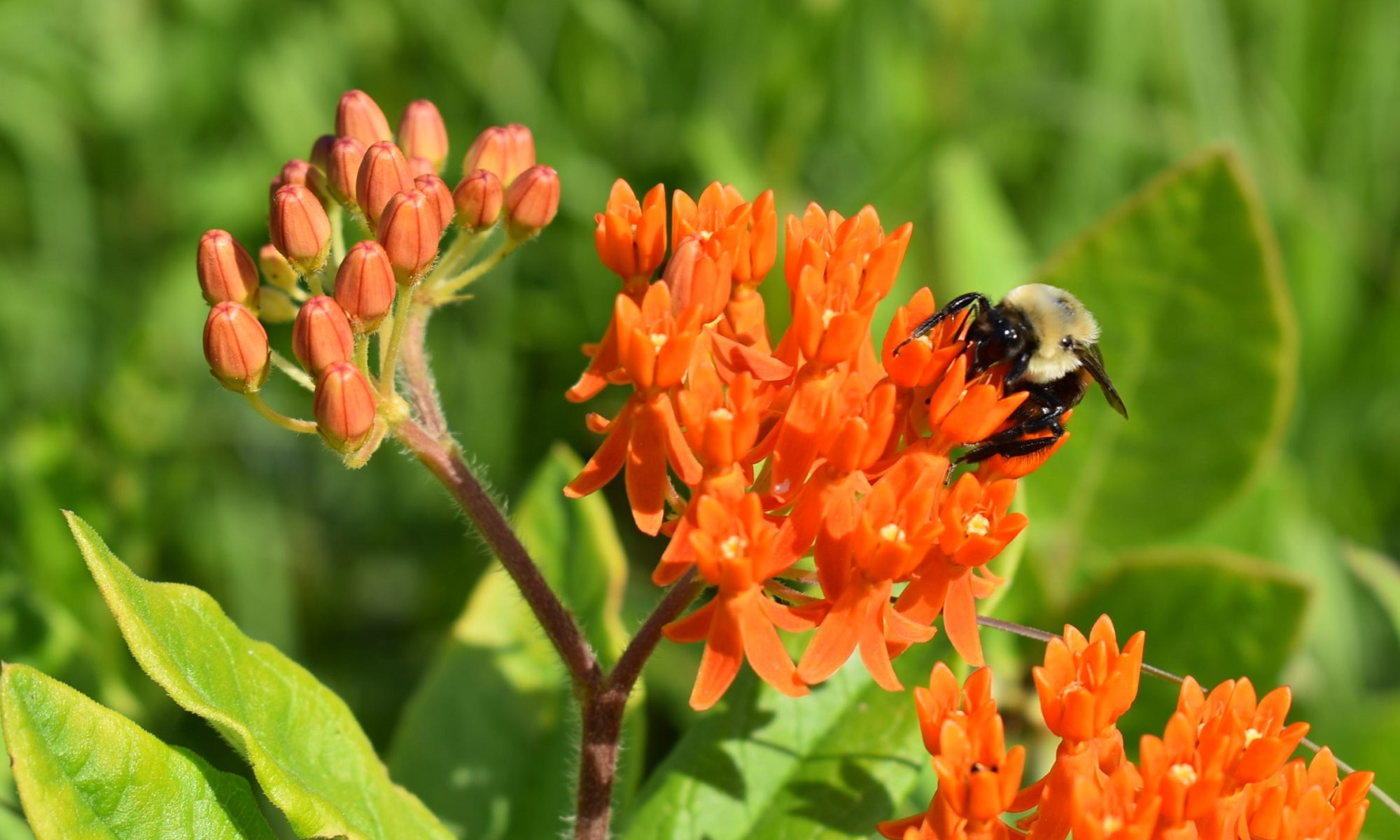
UT Gardens’ August 2022 Plant of the Month
Submitted by Janet Dowlen, Soil Conservationist, Natural Resources Conservation Service, Crossville, Tennessee
Tennessee is fortunate to have 14 native species of milkweed (Asclepias sp.). Most are easily grown from seed and can do well in landscape plantings. All are excellent plants for feeding our native pollinator insects. Butterflies, bees, beetles, flies, moths and a variety of wasp species obtain nectar from milkweed plants.
Milkweeds have become synonymous with the monarch butterfly. Yet, the monarch is one of many insect species that depend on milkweed to complete their life cycle. Other insects use the plants as their sole food source. You will also see them on milkweed, and they should not necessarily be viewed as pests.
Butterfly milkweed (Asclepias tuberosa), also known as butterfly weed, is the most identifiable milkweed species, featuring orange flowers that open in early June. It is also known as “chiggerweed” because it is often found in pastures and roadsides growing with other weeds that people associate with finding chiggers. Yet butterfly milkweed does not harbor the biting arthropods. This milkweed is one of the smaller, more tidy species you can grow in your garden, staying about 24 inches tall. However, it may struggle in overly fertile soils in the home landscape while thriving in a range of poor soils, including heavy clay. Full sun is a must, otherwise the plant stretches to the sun and often flops over.
Butterfly weed is best grown from seed in the location you want it to grow and needs to be left alone after planting. Over time it develops a tap root that is very large and woody, making it nearly impossible to dig up when the plant is mature. Also, the plants are very slow to break dormancy in spring before warm weather arrives, so it is difficult to find it well-grown in pots at early spring plant sales.
Common milkweed (Asclepias syriaca) is also often seen in Tennessee pastures and roadsides. This prolific grower can mature up to 5 feet tall, and its suckering habit will lead to large colonies over time. Common milkweed has pinkish purple, ball-shaped clusters of flowers under its leaves. It is best grown in a wild setting where space is plentiful, otherwise it can dominate a flower bed and tower over, and shade, smaller perennials. This species has wonderfully fragrant flowers, reminiscent of the scent of a rose, and pollinators love them, especially monarch butterflies. When the milkweed is in bloom, you can hear the insect activity simply by standing beside the plant. Common milkweed blooms early to mid June, around the time when butterfly weed blooms. This is the milkweed that is often mowed by road crews. It rebounds quickly and provides fresh leaves for late summer monarchs.
Swamp milkweed (Asclepias incarnata) is lesser known, but it is an easy species of milkweed to grow. Also known as red or rose milkweed, its native range is mostly in Middle and East Tennessee. It grows naturally in wet areas yet tolerates a wide range of soils. Unlike the root systems of common milkweed and butterfly weed, swamp milkweed has a fibrous root system and can easily be divided. It is also grown easily from seed. Swamp milkweed can get 4 feet tall, and its clear pink flowers appear in early July on the Cumberland Plateau (USDA Zone 6b) and earlier for warmer zones. Swamp milkweed is a great plant in the landscape but appreciates extra water in extremely dry periods.
Other interesting milkweeds in Tennessee include poke milkweed (Asclepias exaltata), whorled milkweed (Asclepias verticillata), clasping milkweed (Asclepias amplexicaulis), and redring milkweed (Asclepias variegata).
Researchers have found that habitat for the Eastern monarch butterfly can be improved by cutting back perennial milkweeds in early to mid-summer to encourage new young growth that is more attractive to egg-laying adults that are creating the final generation of the late season southern migration. The plants can be cut back to about 2 to 4 inches tall just when the plants are beginning to flower. To provide a floral display, try cutting back only half the patch to create caterpillar habitat. The University of Tennessee Gardens in Knoxville, Jackson and Crossville grow native milkweed species. The UT Gardens, Crossville, has all three of the species described in this column in its Butterfly Garden. Go for a visit and check them out!
The UT Gardens includes plant collections located in Knoxville, Crossville and Jackson. Designated as the official botanical garden for the State of Tennessee, the collections are part of the UT Institute of Agriculture. The Gardens’ mission is to foster appreciation, education and stewardship of plants through garden displays, educational programs and research trials. The Gardens are open during all seasons and free to the public. For more information, see the Gardens website: utia.tennessee.edu/state-botanical-garden.